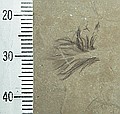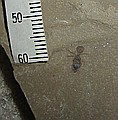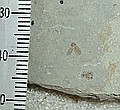
Top:
Populus wilmattae
(Salicaceae)
Morphotype ID: PC006
(PCnnn is Parachute Creek with sequential number)
Bottom:
?
|

Left: Populus wilmattae
(Salicaceae)
Morphotype ID: PC006
Right: ?
|

Pile of wrapped fossils that are research specimens for the Utah Field House in Vernal.
|

Populus wilmattae
(Salicaceae)
Morphotype ID: PC006
|

Macginitiea wyomingensis
(Platanaceae)
Morphotype ID: PC001
|

Leguminosites
(Leguminosae)
Morphotype ID: PC044
|

Populus wilmattae
(Salicaceae)
Morphotype ID: PC006
Leaf shows damage from gall (wasp injects larvae) or fungal damage.
|

Possibly;
Celtis mccoshii
(Ulmaceae)
Morphotype ID: PC043
|

Possibly insect larva (Diptera: cf. tipulidae; crane fly). Some think it is a dragonfly tail with attached stinger.
|

Small 5 petal flower
Morphotype ID: PC134
|

Small 4 petal flower
Morphotype ID: PC131
|

Macginitiea wyomingensis ("The Perfect Macginitiea")
(Platanaceae)
Morphotype ID: PC001
|

Macginitiea wyomingensis ("The Perfect Macginitiea")
(Platanaceae)
Morphotype ID: PC001
|

Macginitiea wyomingensis ("The Perfect Macginitiea")
(Platanaceae)
Morphotype ID: PC001
|

Looks like a root ball?
|

Fossil leaf in bowl-like depression.
|

Possibly
Leguminosites
(Leguminosae)
Morphotype ID: PC044
|

Macginitiea wyomingensis
(Platanaceae)
Morphotype ID: PC001
|

Populus wilmattae
(Salicaceae)
Morphotype ID: PC006
|

Cedrelospermum nervosum
(Ulmaceae)
Morphotype ID: PC015
Three leaves on top of one another.
|

Styrax transversa
(Styracaceae)
Morphotype ID: PC041
|

Parvileguminophyllum coloradensis
Morphotype ID: PC012
|

Top: Aleurites glandulosa
(Euphorbiaceae)
Morphotype ID: PC005
Lower Left: Equisetum
(Equisetaceae) - horsetail, scouring rush
Morphotype ID: PC016
Lower Right: Lygodium kaulfussii
(Schizeaceae)
Morphotype ID: PC010
|

Top: ?? Possibly Populus cinnamomoides
(Salicaceae)
Morphotype ID: PC008
Bottom: Populus wilmattae
(Salicaceae)
Morphotype ID: PC006
|

Heart-shaped leaf. Could grow like this naturally, but more likely due to initial damage from insects that caused distorted growth.
|

Counterpart of previous heart-shaped leaf.
|

Both parts of previous heart-shaped leaf.
|

Macginitiea wyomingensis
(Platanaceae)
Morphotype ID: PC001
|

Huge containing many different leaves of several different species.
Macginitiea wyomingensis (large leaves on left and right)
(Platanaceae)
Morphotype ID: PC001
Top Left: Lygodium kaulfussii
(Schizeaceae)
Morphotype ID: PC010
|

Left to Right: Glade Gunther, Kirk Johnson, Rich Barclay & Paul Brown working on large slab
|

Posing (resting!)
|

Rich Barclay with one of our best finds - a very well preserved species in the chocolate family.
Sterculia coloradensis
(Sterculiacaea)
Morphotype ID: PC003
|

Sterculia coloradensis
(Sterculiacaea)
Morphotype ID: PC003
Very well preserved species in the chocolate family.
|

Sterculia coloradensis
(Sterculiacaea)
Morphotype ID: PC003
Very well preserved species in the chocolate family.
|

Sterculia coloradensis
(Sterculiacaea)
Morphotype ID: PC003
Very well preserved species in the chocolate family.
|

Sterculia coloradensis
(Sterculiacaea)
Morphotype ID: PC003
Very well preserved species in the chocolate family.
|

Sterculia coloradensis
(Sterculiacaea)
Morphotype ID: PC003
Very well preserved species in the chocolate family.
|

Splitting rock slabs is like flipping the pages of a book on earth's history. In this case, it's a rather large book!
|

Possibly Morphotype ID: PC127
|

Allophylus flexifolia
(Sapindaceae)
Morphotype ID: PC018
|

Insects: Diptera: cf. tipulidae (crane flies)
These adult crane flies died and settled in trough of ripples in the lake. They were only dead a few days with most missing their wings, but bodies still intact.
|

Insects: Diptera: cf. tipulidae (crane flies)
These adult crane flies died and settled in trough of ripples in the lake. They were only dead a few days with most missing their wings, but bodies still intact.
|

Equisetum
(Equisetaceae) - horsetail, scouring rush
Morphotype ID: PC016
|

Macginitiea wyomingensis
(Platanaceae)
Morphotype ID: PC001
|

Liquidambar lesquereuxi - Sweet gum
(Hamamelidaceae)
Morphotype ID: PC002
Leaf shows insect damage (3 wholes to right of primary vein)
|

Possibly insect larva (Diptera: cf. tipulidae; crane fly). Some think it is a dragonfly tail.
|

Possibly insect larva (Diptera: cf. tipulidae; crane fly). Some think it is a dragonfly tail with attached stinger.
|

Feather
|

Possibly insect larva (Diptera: cf. tipulidae; crane fly). Some think it is a dragonfly tail.
|

Ant
|

Ant (close-up of previous image)
|

COLEOPTERA, Carabidae
Beetle
(see: http://www.ucmp.berkeley.edu/
tertiary/eoc/greenbugs.html)
|

Insect (beetle?)
|

COLEOPTERA, curculionidae
(A weevil, herbivorous insect with long snouts)
See:
http://www.ucmp.berkeley.edu/tertiary/
eoc/greenbugs.html
http://www.coloradomtn.edu/campus_rfl/
staff_rfl/kohls/coleoptera.html)
|

Bee? Possibly DIPTERA, myiomorpha.
(see: http://www.coloradomtn.edu/
campus_rfl/staff_rfl/Kohls/diptera.html)
|

Grasshopper
|

Grasshopper
|